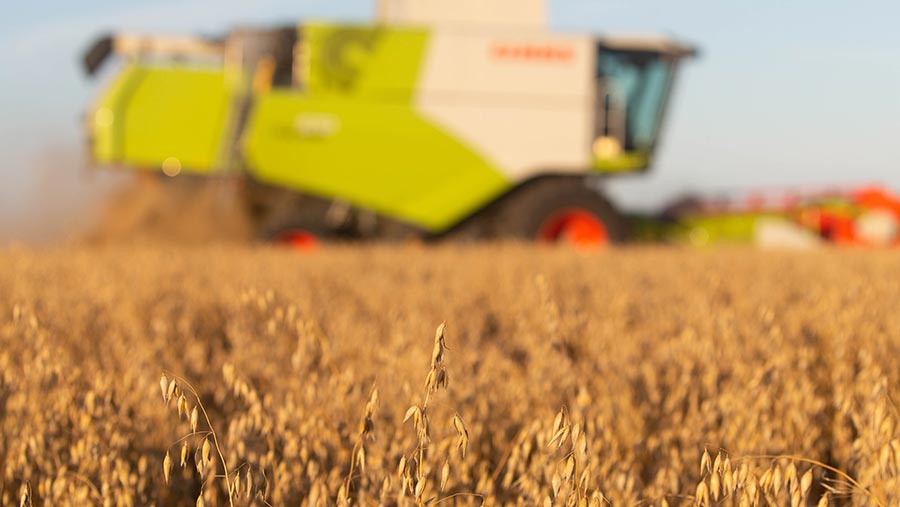Harvest 2021: Pockets of cereals and beans still to cut
 © Tim Scrivener
© Tim Scrivener Combines are mostly cleaned down for the winter as drills come out in force, but a few cereals and beans remain to be gathered in.
East Lothian
In Scotland, James Grant-Suttie finished combining wheat two weeks ago at Balgone Farms, North Berwick, and is now waiting on Fuego spring beans to ripen. “They’re about a week away and they look well,” he said.
See also: 5 cultivation and establishment methods compared
“We’ve had a good harvest all round; decent yields, good quality, cut dry – and we finished wheat well ahead of normal – it’s been quite enjoyable.”
Elation and Skyscraper averaged 11t/ha, with little difference between first and second wheats or between varieties. “The heavier land did better than the light,” he said.
Most came off at 15-17% moisture compared with 18-20% in a normal year, Mr Grant-Suttie said. “We were delighted – and prices are decent, too.”
High erucic acid rapeseed ranged from 3.8t/ha to 5t/ha, and averaged 4.2t/ha – below the usual 5t/ha due to being on lighter land.
“Spring barley had one of the best years in a long time; Laureate averaged 8.5t/ha and the quality was good,” he added.
Where spring barley was sown after a winter cover crop it performed particularly well. “We’re getting more wet winters and dry springs, and it preserved the moisture better – we’ll continue to do that now.”
Yorkshire
Keith Snowball is similarly pleased with his harvest at High Farm, Brandsby, where everything is in the barn bar the beans.
“Orwell winter barley did marvellously; we had 14ha and it did 10t/ha over the weighbridge,” he said.
Windozz oilseed rape was above average at 4.15t/ha. “We had a 12ha field which did 5t/ha but then another 6.5ha let us down – anything that stood with its feet wet has struggled.”
Crusoe winter wheat exceeded expectations, with first wheats at 9-12t/ha and second wheats at 8.6t/ha. “Protein was a bit low at 12% and Hagbergs died a little – first cuts were at 410 seconds but later fields were down at 230-240.”
Isabelle and Mascani oats (spring and winter, respectively) both averaged 7.4t/ha, but green straw made for slow combining, said Mr Snowball.
Although most crops are cleared in the area, further east there’s still wheat left to cut.
“And people are struggling to get hold of seed – I think supplies are tight due to the later harvest and quality issues in the south.”
Lincolnshire
Turning the usual course of events on its head, a slow, damp and overcast harvest further south made for a frustrating couple of months for David Hoyles at Monmouth Farm, Long Sutton.
“We finished the wheat on 8 September and the poorer looking crops, which established later in wet conditions, did about 1t/ha above expectations, while the better looking crops, drilled earlier into stronger ground, did about 3t/ha worse than expected.”
With 20% less sunlight up to June, Mr Hoyles reckoned the thicker crops didn’t get sufficient light to fill, so yielded 15% below average, while the thinner crops were close to the five-year average. “Overall we averaged 10t/ha; we’re normally nearer 12t/ha.”
Graham yielded 1t/ha above everything else, with Dawsum in second place and Skyscraper in third. “The Dawsum looks interesting, it was very clean on disease with a high specific weight.
“We grow all first wheats, with 70% going for seed – the specific weight was a bit close for comfort but quality was OK,” he added. “I’m a bit disappointed with our yields but the price has saved us.”
Wiltshire
The weather also proven difficult for James Dean at Church Farms, Porton, Salisbury. “The wheat quality was variable – mostly the protein was there but Hagbergs were varied.”
He hopes the Crusoe, Siskin and Extase will have averaged above 3.5t/ha, slightly below the normal 4t/ha.
“We do hay and straw contracting, which has been a nightmare trying to get anything dry. We had to turn it in the morning, bale in the afternoon and stop in the evening as it was too wet again – we ended up chopping a lot of our wheat straw.”
The lack of sunshine meant most of the winter crops yielded no better than average, while spring barley was really good. “Feed barley made 8.6t/ha while Craft malting barley did 7.4t/ha – and all made the grade,” said Mr Dean.
Oilseed rape averaged 3.5t/ha; grown with buckwheat and sown into long stubble, it didn’t suffer from flea beetle. “It seems to work,” he said.
Winter naked oats proved disappointing, at 4.9t/ha, while spring naked oats did well, at 6.2t/ha, he added. “Normally the yields would be the other way around.”

